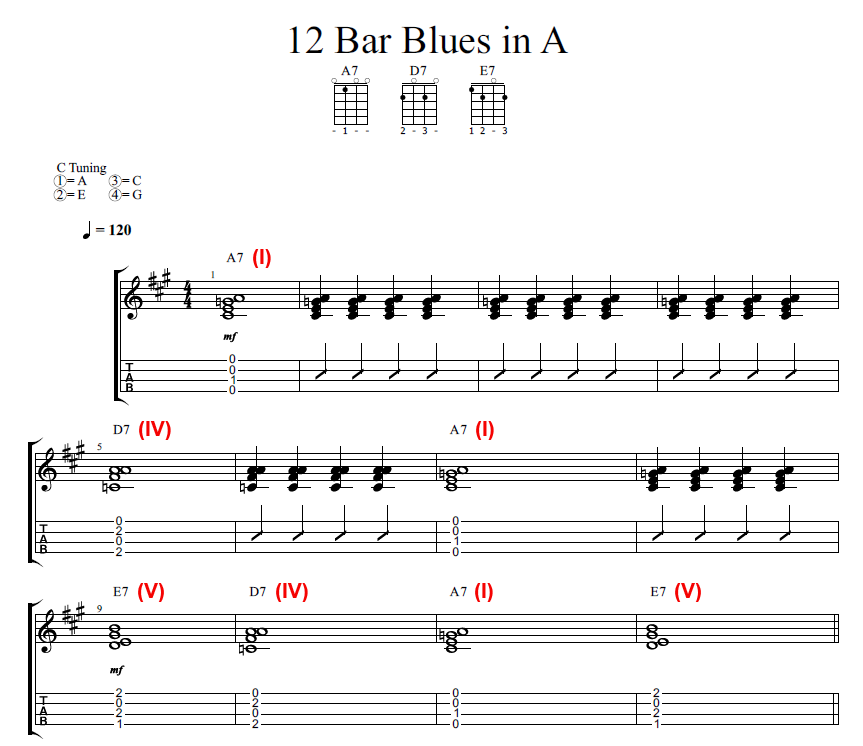Understanding the 12 Bar Blues Form
Blues is undoubtedly one of the most popular forms of music to come out of America. The simplicity of blues is what draws people to it. With only 3 chords in a 12 bar blues, it has the power to move you. In today's lesson, we are going to take an in-depth look at how the form, or structure, of a blues chord progression is made.
Let's use the key of A Major as our base.
Harmonization of A Major

The image above represents the harmonization of the A Major scale.
Scale & Formula
As with every major scale, we have a formula of: 1 2 3 4 5 6 7
The major scale is formed by a series of whole steps and half steps: Whole step, whole step, half step, whole step, whole step, whole step, half step
For example: A to B is a whole step, B to C# is a whole step, C# to D is a half step, and so on.
Quality
Chords are formed by stacking thirds. In other words, skip one letter in-between.
Here is a quick run down of 7th chord formulas:
Maj 7 - 1 3 5 7
Dom 7 - 1 3 5 b7 (represented as a stand alone '7' - i.e. chord 5 [E7 or E Dominant])
min 7 - 1 b3 5 b7
min7b5 - 1 b3 b5 b7
It's important to note that there are three qualities of chords: Major, Minor, and Dominant.
Remember, we must always compare the chord to the parent scale.
For example: B is the ii chord. But, why is it a minor 7 in the key of A Major? Let's break it down.
Skipping thirds we have: B D F# A in the key of A Major.
Compare those notes against the parent scale of B Major: B C# D# E F# G# A#

B remains the same (1)
D# becomes D (b3)
F# remains the same (5)
A# becomes A (b7)
Thus, our second chord in the key of A Major is: B min7 (1 b3 5 b7)
So why do all these chord qualities and formulas matter?
Most pop songs you hear on the radio are very cookie-cutter or square. They follow the rules written above, in that the chords of the key are the only chords to be used in the song. Blues, on the other hand, has its own rules.
The Blues Rules
- The chord progression is always I, IV, V.
- A = I
- D = IV
- E = V
- Blues is dominant by its culture. This means that the three chords will each be dominant.
- A Maj 7 (I) becomes: A7
- D Maj7 (IV) becomes: D7
- E7 (V) remains: E7
- This means that we will need to alter the I chord and IV chord to dominant.
A Maj 7 becomes A7 by flatting the 7th: A C# E G (1 3 5 b7)
D Maj 7 becomes D7 by flatting the 7th: D F# A C (1 3 5 b7)
E7 remains unaltered, as it was dominant to begin with: E G# B D (1 3 5 b7)
- This means that we will need to alter the I chord and IV chord to dominant.
- The form of a blues song is almost always 12 bars.
Let's look at how these rules fall into place in the 12 bar form.
12 Bar Blues Form
Below is the standard 12 Bar Blues form in A major.

As we can see above, the progression is as follows:
Bars 1 - 4: A7
Bars 5 - 6: D7
Bars 7 - 8: A7
Bar 9: E7
Bar 10: D7
Bar 11: A7
Bar 12: E7 *
* Note: When you end the song, bar 12 will be played as A7 (I)
We could also think of it in chord numbers:
Bars 1 - 4: I
Bars 5 - 6: IV
Bars 7 - 8: I
Bar 9: V
Bar 10: IV
Bar 11: I
Bar 12: V *
What to take away from this lesson
This lesson covered some pretty heavy music theory in the form of harmonizing chords from scales. All you really need to remember to be a blues cat is:
- Memorize the order of the 12 bar form.
- Remember the progression is I, IV, V. Regardless of the key.
- Remember to make each chord dominant.
Here is a simple blues tune you can learn with us on Rock Class 101. Guess what, it's in the key of A too!
Click HERE to visit the lesson page. Premium Membership is required to access the interactive tab play and step-by-step lesson video.
Article by: Andrew Hardel
